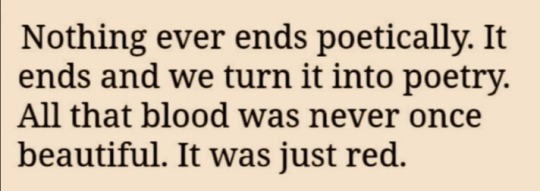Emily | Undiscovered National Treasure |Writer | Wants Vampire Trend to Come Back
Don't wanna be here? Send us removal request.
Text
Travel and tell no one. Live a true love story and tell no one. Live happily and tell no one. People ruin beautiful things.
Khalil Gibran
60K notes
·
View notes
Text
“But good God, what’s wrong with me, after all? What am I missing? Why this emptiness, this nostalgia? What is this anxiety, as if I only loved something I didn’t know?”
— Clarice Lispector, from a letter to Fernando Sabino featured in Why This World
7K notes
·
View notes
Text
“I’m not everything I want to be but I’m more than I was, and I’m still learning”
— Charlotte Erikkson
55K notes
·
View notes
Text
“I’d kill for you. Please ask me to kill for you.” “No.” Is a top tier ship dynamic no I do not take criticism
270K notes
·
View notes
Text
I love people who go the extra mile for you, like that stranger that asks you if your okay when they see your eyes getting watery or that person that tries hard to make sure they pronounce your name correctly or the lecturer that makes sure everyone understands the course material and doesn’t move on till everyone does, they’re beautiful people and I love them.
19K notes
·
View notes
Text
i love tragedy i love circular narratives i love ppl who cannot escape their fate & characters that have been dead since the beginning
76K notes
·
View notes
Text




“I could have told you 'bout the long nights, how no one loves the birds that don't rise”
3K notes
·
View notes
Text
getting real tired of people being like “this book, from 1503, is not woke, and so no one should ever read it again” like y’all just use some critical thought
9K notes
·
View notes
Text
The raging urge to be a villain’s favorite person.
32K notes
·
View notes
Text
There’s something truly exquisite about stories where the real tragedy is the price you paid to stand on top of the world
90K notes
·
View notes
Text
“I like art, and by art I mean music, poetry, sex, paintings, the human body, literature.. All of this is art to me.”
— Hunter Reve (via raysofthesun)
914K notes
·
View notes
Text
The Four Act Story Structure (with Black Panther)
Part 1 - Orphan
Narrative Context: Set Up the story. In the first 20% - 25% of your novel, you will: Introduce the character (backstory, their stasis, their inner demons, their strengths), establish stakes (what the character has to lose), foreshadow the imminent conflict to come.
Hook: The hook happens in the first chapter of your novel, the earlier the better. It grabs the reader, makes us empathize with the protagonist, and gives the reader something to bite into before the protag’s quest really begins.
Example: (Black Panther) Freeing kidnapped women from warlords to call Nakia back to Wakanda.
Inciting Incident: Something happens to your character that incites the coming conflicts. This could happen as early as the hook, or could happen as late as Plot Point 1.
Example: Klaw and Killmonger steal vibranium from a British museum.
Plot Point 1: At 20% or 25% in your novel, something big happens that alters the protag’s plans/status/beliefs, forcing them to respond. The first plot point defines the nature of the hero’s quest, and everything you’ve set up (stakes, inner demons, foreshadowing) has led up to this point. Imagine the first quarter of the novel as pulling back the plunger in a pinball machine, and the first plot point is when you let the ball fly. The antagonist is introduced, but their true nature will not be fully revealed until the midpoint.
Example for Plot Point 1 from Black Panther: ~35m/123m (28%), Klaw’s whereabouts are known. T’Challa needs to go on a retrieval mission, putting his leadership as King to test for the first time.
Part 2 - Wanderer
Narrative Context: Reaction. 25% - 50% of your story. Something big has just happened (Plot Point 1) and the protagonist is reacting to it, running from it, pursuing it without knowing what it is. There is a sense of indecision, or lack of knowledge. We don’t have all the answers.
Example: T’Challa, Nakia, and Okoye are after Klaw, but they haven’t been fully introduced to the true antagonist, Killmonger.
Pinch Point 1: The first Pinch Point comes in the middle of Part 1. A pinch point is a big moment that reminds the reader of the power of the antagonist.
Example: 59/123 min, 47%. Right when the gang thinks they’ve got Klaw, he escapes with the help of Killmonger. T’Challa sees Killmonger for the first time, taking notice of the ring he wears. Who is this man? T’Challa realises he doesn’t have all the answers, that there’s something bigger going on.
Midpoint: One of the biggest points in the story, and a huge plot twist that reveals the true nature of the antagonist. It is like a veil is lifted, and the character sees more clearly what they’re up against, on an external, internal, and thematic level.
Example of the Midpoint: In Black Panther, the midpoint happens from 63 min - 67 min (~52%) in two scenes. First, we get a big plot twist. Killmonger reveals that he is of Wakandan blood, and that he’s going to the hidden nation. He kills Klaw and even his own girlfriend without hesitation. This lets the viewer know Killmonger’s goals and the danger he poses as an antagonist. In the second scene of the Midpoint, Zuri reveals what really happened to T’Challa’s uncle (and Killmonger’s father): he was killed by T’Chaka, leaving Killmonger fatherless. T’Challa realises that he’s going to have to pay the consequences for his father’s mistakes, and truly questions for the first time whether Wakanda’s tradition of secrecy is moral.
Part 3 - Warrior
Narrative Context: Action. 50% -75/80% of your story. Again, something game changing has just happened (the midpoint), which suddenly clarifies the nature of the antagonistic force. With this new insight, the protagonist is able to go on attack mode, actively trying to solve the issue at hand.
Example: Now that Killmonger has made himself known as the true antagonist, T’Challa has to face him and the mistakes T’Chaka made in the past.
Pinch Point 2: The second pinch point occurs halfway through the third quarter. Like the first pinch point, it is a reminder of the threat of the antagonistic force.
Example: 81 min - 82 min in Black Panther, or 66% into the story, Killmonger overthrows T’Challa.
Plot Point 2: The second plot point happens around 75% or 80% into the novel. It may be a characters realisation of what they must do to defeat the antagonist or a piece of information that allows them to face the bad guy. Whatever it is, no new information may be introduced after this point unless it is heavily foreshadowed. This is to prevent a deux ex machina.
Example: (98 min, 80%) T’Challa speaks to his forebears and realises that their actions were immoral. He says, “I must take the mantle back” and regains his power as black panther. He is ready to face Killmonger, and there is a sense that he now has a chance of defeating him.
Part 4 - Martyr
Narrative Context: Martyr. 75/80% - 100% of your story. This is the final battle, the end game. Often in a self-sacrificial way, the protagonist faces the big baddies and defeats them one by one. They are heroic, they are active, and they defeat the antagonist by their own strength.
Example: T’Challa and his crew face Killmonger to stop him from sending Wakandan weaponry to other countries. Notice that each character, T’Challa, Shuri, Okoye, Nakia, and Ross do something heroic and self-sacrificing. Occasionally something comes in that turns the tides in the heroes’ favour (this must be heavily foreshadowed) like when M’Baku decides to join sides with T’Challa.
Climax: Close to the end, midway in Part 4, the antagonist is defeated and the theme is clearly splayed out.
In Black Panther, this happens at 115 min - 118 min (or 94%) when T’Challa brings Killmonger out of the vibranium mines to see the Wakandan sunset. Killmonger chooses to die rather than live in bondage. After this point, we switch to the resolution.
Resolution Scene: Everything is wrapped up after the climax. This isn’t necessarily one scene, but can be many. May be one chapter or several depending on how many plot threads need to be tied up. Whatever happens, we enter into a new stasis and see the effect of the protagonist’s journey both physically (how the world changes around them) and psychologically (how they have changed internally).
Example: In Black Panther, we find out that T’Challa has decided to make an outreach program for African-American youth. He learns from Killmonger and decides to use Wakandan technology and resources so that the future generation does not suffer like Killmonger did.
How to use the Four Act Story Structure
On a practical level, how can writers use the Four Act Structure? I would recommend using it both in reading and in writing:
When reading or watching a movie, look out for the major plot points and act breaks. Have you ever felt that a story feels unbalanced? Rushed in parts? It is likely because it does not follow the Four Act Structure.
You can also use this structure in outlining. It will prevent you from going, “What the hell is going to happen next?” and will help you create a story that is well structured. Another reason I like this structure is because it details how to plot the middle portion of a novel.
However, keep in mind that movies are paced differently than books, and that even all books aren’t paced the same. You will not die in writers hell if you don’t follow this structure exactly. Rather, it is good to understand why this structure works so that you can better structure your own novels. For instance, Harry Potter and the Philosopher’s Stone does not follow this structure like I’ve laid out (though many argue that the first book is unbalanced; Harry doesn’t get to Hogwarts until 40% into the book.)
If you’d like to read more in depth about the Four Act Structure, Larry Brooks writes about it in Story Engineering. But a word of warning: Brooks does seem to believe that you will die in writing hell if you don’t follow this structure, and he hates pantsers with a passion. It’s still an informative read, but please take everything he says with a grain of salt.
800 notes
·
View notes




